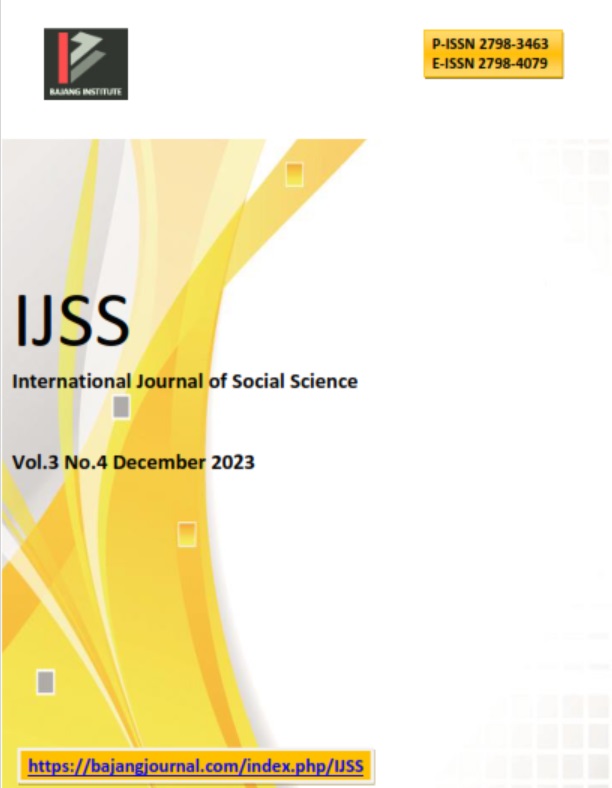AN ANALYSIS OF JARGONS USED BY RECEPTIONISTS IN FRONT OFFICE HOTELS AT LOMBOK
DOI:
https://doi.org/10.53625/ijss.v3i4.7166Keywords:
Jargon, Front Office, Department, Lombok HotelAbstract
This study aimed at identifying and describing the linguistic forms, the meanings and the functions of jargon used by receptionists of the front office department at Lombok Hotel. This study was conducted in qualitative method. The front office jargons were investigated in spoken and written forms. The subjects of this study were receptionists of the front office department at Lombok. The methods of data collection were observation, documentation and interview. This study found jargon were used by receptionists in front office department. It was found that the jargon was in the form of noun phrases abbreviation, noun, clipping, affixation, borowing , acronym , preposition phrases , verb , adjective , and coinage . The meanings of jargon were identified by investigating technical meaning. Besides, this study found that there were two functions of the jargon, (1) providing a technical or specialist language to make communication more efficient and (2) encouraging group solidarity. This study concluded that jargon is a way toexpress the feeling of the community and also have their own specific language
References
Allan, K,&Burridge, K. 2006 ForbidenWords: Taboo and the Censoring of Language. Cambridge: Cambribge University Press.
Babbie, Earl R. The Practice of Social Research. 12th ed. Belmont, CA: Wadsworth Cengage, 2010; Muijs, Daniel. Doing Quantitative Research in Education with SPSS. 2nd edition. London: SAGE Publications, 2010.
Bobanovic, K. M., & Grzinic, J. (2011). The importance of English language skills in the tourism sector: A comparative study of students/employees perceptions in Croatia. AlmaTourism 2.4, 10-23.
Bosch, E., Jiménez, R. (2001). Tourist's needs versus student's needs: A pedagogical approach to teaching English for tourism. In S. Posteguillo , I. Fortanet & J.C. Palmer. (eds.). Methodology and new technologies in languages for specific purposes. Castellón: Universitat Jaume I: 241-249.
Carvajal, A. E. (2014). Importancia y reflexiones sobre la investigación y publicación científica desde pregrado. SCientifica, 12.1, 7-8.
Chaer, A &Agustina, L. 2010.SoociolinguisticPerkenalanAwal. RinekaCipta. Jakarta.
Fromkin, V. Rodman, R. and Hyams, N 2003.An Introduction to Language.Seventh Edition. United States: Wadsworth Thompson US.
Farfan, G, Villafuerte, J., Romero, A., & Intriago, E. (2017). Tecnologías de apoyo para el fortalecimiento de las destrezas comunicativas en lenguas extranjeras estudio de caso: filmes cortos producidos por futuros docentes de inglés. PixelbitRevista de Medio y Educación 51, 183-195
Holmes, J. 2001. An Introduction to Sociolinguistics.Second Edition. London: Longman. Inc.
Kostic Bobanovic, M., & Grzinic, J. (2011). Importance of English language skills in the tourism sector: A comparative study of students/employees perceptions in Croatia. Alma Tourism 4, 10-23.
Leslie, D., & Russell, H. (2006). The importance of foreign language skills in the tourism sector: A comparative study of student perceptions in the UK and continental Europe. Tourism Management, 27.6, 1397-1407.
Miles, Mattew and Huberman,Michael. 1994. Qualitative Data Analysis. London: Sage Publications.
Niño-Puello, M. (2013). El inglés y su importancia en la investigación científica : Algunas Reflexiones. Revista Colombiana de ciencia, 5.1, 243-254.
Rojas, M. (2018). Role-plays as an assessment tool in English as a Foreign Language (EFL) class. In S.T. Soto, E. Intriago, J. Villafuerte (eds.), Beyond Paper and Pencil Test: Good Assessment Practices for EFL Classes. Machala: Editorial UTMACH, 49-73
Rutherford, D. G. and Michael, J. O. 2007.Hotel Management and Operations.Fourth Edition. New Jersey: John Wiley & Sons, Inc.
Pupo, F., S., Faedo-Borges, 18.2, 1-11.
Sugiyono. 2010.Metode Penelitian Kuantitatif Kualitatif dan R&D. Bandung: Alfabeta
Suwithi, W. N. &Boham. C. E 2008. Akomodasi Perhotelan 1, 2, dan 3untuk SMK Pariwisata. Jakarta: Direktorat Pembinaan Sekolah Menengah Kejuruan, Direktorat Jendral Manajemen Pendidikan dasar dan Menengah, Departemen Pendidikan Nasional.
Seidlhofer, B. (2005). English as a lingua franca. ELT Journal, 59.4, 339-341.
Soto, S. T.; Espinosa, L.F.; Vargas Caicedo, E; Illescas; Fontaines-Ruiz, T.; Carrera, D. (2017). How Does Explaining Content Through Videos Benefit Language Learners? Esp Students Tell us About it. Turkish Online Journal of Educational Technology. Special Issue for IETC 2017. 385-391.
Villafuerte, J., Intriago, E., & Romero, A. (2018). Promoción de la comprensión lectora interactiva en idioma inglés. Revista Refcale, 6.2, 49-69.
Wardaugh, R. 2006. An Introduction to Sociolinguistics: Forth Edition. Oxford: Blackwell Publishing.
Yule, G. 2006. The Study of Language.3rd Edition.Cambrige University Press
ZahedpishehNahid, & Abu BakarBZulqarnain. (2017). English for Tourism and Hospitality Purposes. English Language Teaching 10.9, 86-94.
Downloads
Published
How to Cite
Issue
Section
License
Copyright (c) 2023 Siti Lathifah

This work is licensed under a Creative Commons Attribution 4.0 International License.

















